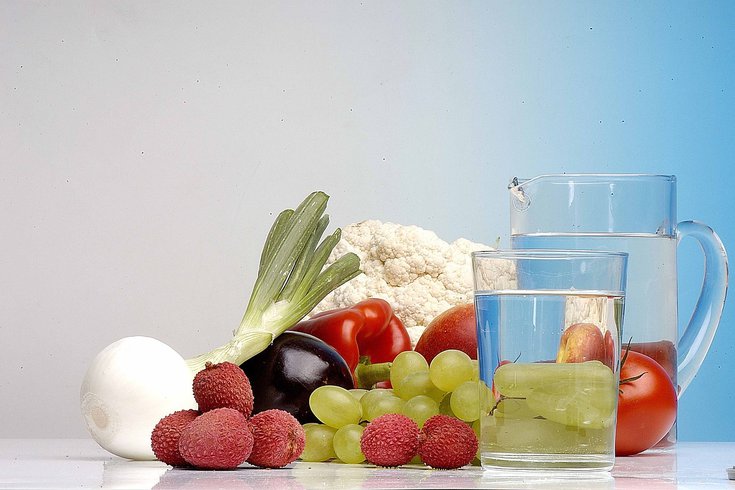
December 28, 2022
 Guillermo de Casanova/Pixabay
Guillermo de Casanova/Pixabay
The volumetrics diet is considered a safe and effective way to lose weight. The approach helps people shed pounds while not feeling hungry by emphasizing lower-calorie dense foods like fruits, vegetables, broth-based soups and whole grains.
People looking to lose weight, but seeking a newer approach to dieting, may want to give the volumetrics diet a try.
This volumetrics diet emphasizes lower calorie-density foods, nutrient-dense foods like fruits, non-starchy vegetables, broth-based soups, whole grains and low-fat dairy. These foods have high water contents, which allow people to feel full while ingesting fewer calories.
The diet recommends people limit their consumption of high-calorie density foods. These include processed foods and fatty meats like bacon and sausage, but also some foods that are rich in healthy fats, like nuts, seeds and oils.
The basic idea is that by eating more lower-calorie density foods, people can eat bigger portions while still staying within their caloric goals for the day. They can cut the calories necessary to lose weight without feeling hungry.
The volumetrics diet was created by Penn State University nutrition professor Barbara Rolls who has detailed the science behind the approach in three books; her latest book, "The Ultimate Volumetrics Diet," was published 10 years ago. She breaks foods into four categories based on their density:
• Category One: Very low-density foods like broth-based soup, nonfat yogurt, non-starchy vegetables and fruits
• Category Two: Low-density foods like breakfast cereal, legumes, chili, spaghetti, lean proteins (poultry and fish), starchy vegetables and whole grains
• Category Three: Medium-density foods like bread, cheese, cake, french fries, ice cream, pretzels and pizza
• Category Four: High-density foods like butter, candy, chips, chocolate, cooking oil, crackers, nuts, pretzels and trail mix
The volumetrics diet recommends people mostly select foods from the first two categories. They should consume smaller portions of category three foods and limit those from category four.
Health experts say this eating approach is safe and nutritious, but it does require a more intense meal planning and portioning of meals. If you're considering adopting the volumetric diet in the new year, here's what you should know.
In general, diets that are rich in low-calorie dense foods effectively help people lose weight while still leaving them feeling full, according to the U.S. Centers for Disease Control and Prevention. These diets also have been shown to help people maintain their weight-loss gains.
A 2014 review of different diet strategies, found this dieting approach to be safe and effective. It also helped foster long-term, healthy eating habits. Additional research has shown that paying attention to the energy densities of food can help people who are obese manage their weights.
Some studies also suggest that this diet approach can help decrease inflammation, blood pressure and the risk of heart disease, diabetes and other conditions. A 2017 study found that women who ate diets higher in energy density had a 24% greater risk of developing type 2 diabetes than those who followed a lower-energy-density diet.
More research is needed to confirm the specific health benefits of the volumetric diet, some experts say.
When a balanced diet of essential nutrients is consumed, the volumetrics diet is considered safe to follow, but people need to make sure they are eating enough healthy foods with high-energy densities, like nuts, seeds and oils.
Some health experts warn that the volumetrics diet places too much emphasis on calories, noting that not all low-calorie foods are healthy. For example, this diet recommends limiting nutritious foods such as avocados, nut butter and whole eggs, but places no restrictions on diet ice cream because it has few calories.
Additionally, the diet should not be used by people who are not recommended to lose weight. This includes pregnant women, children, people with weakened immune systems, those with a history of eating disorders or poorly controlled chronic conditions, and people who are underweight or have a healthy weight.
Before embarking on this diet, people need to learn to recognize foods by their energy densities. Stock the kitchen with fresh fruits, fresh or frozen vegetables, beans and legumes, whole grains, fiber-rich breakfast cereals, low-fat fish, poultry without skin and lean meats.
Here are some sample meal combos from U.S. News & World Report, Everyday Health and VeryWell Fit that can help people get started.
For breakfast:
• Two cups of cornflakes, half of a banana, a cup of low-fat milk and a cup of blueberries
• Oatmeal topped with apple slices, cinnamon and a sprinkle of brown sugar, coffee and half a grapefruit
• Boiled eggs, steamed asparagus and whole-grain toast
For lunch:
• A cup of black bean soup with a three-ounce, lean burger on a whole heat bun with lettuce, tomato and ketchup, and two clementines
• Grilled chicken salad with chopped romaine lettuce, red bell pepper, 1 teaspoon of crumbled blue cheese and chopped walnuts with whole-wheat pita bread and strawberries
• Tuna with avocado, cucumber and lettuce on whole wheat bread
For dinner:
• Poached salmon with yogurt dill sauce, minted broccoli, a half cup of cooked brown rice and a spinach salad with homemade orange-poppy seed dressing
• Chicken breast, mushrooms and bell peppers in marinara sauce with black bean noodles
• Steak fajita with grilled green peppers and onions, salsa, shredded romaine lettuce, diced fresh tomato, corn kernels and nonfat sour cream on a tortilla and cantaloupe.